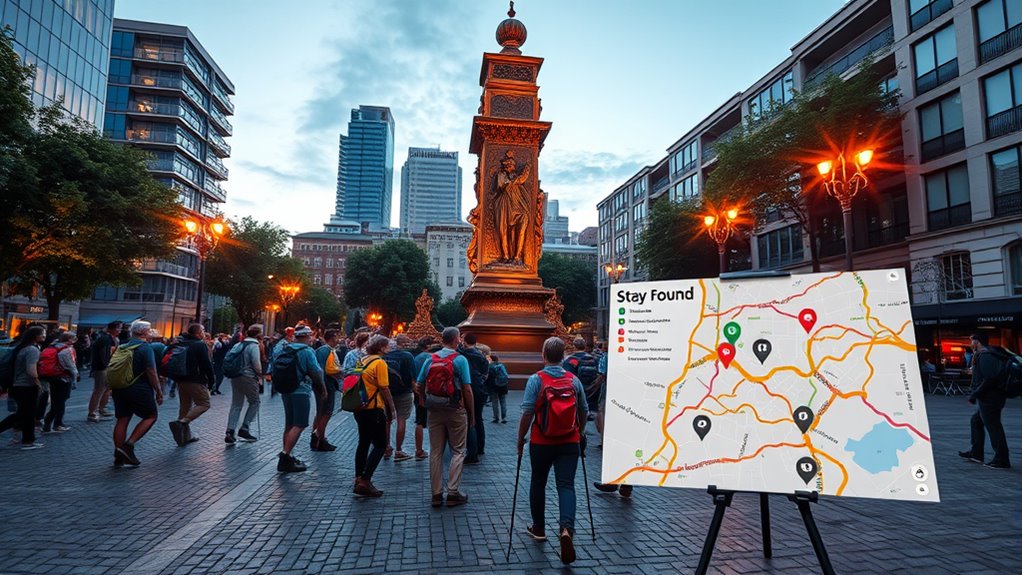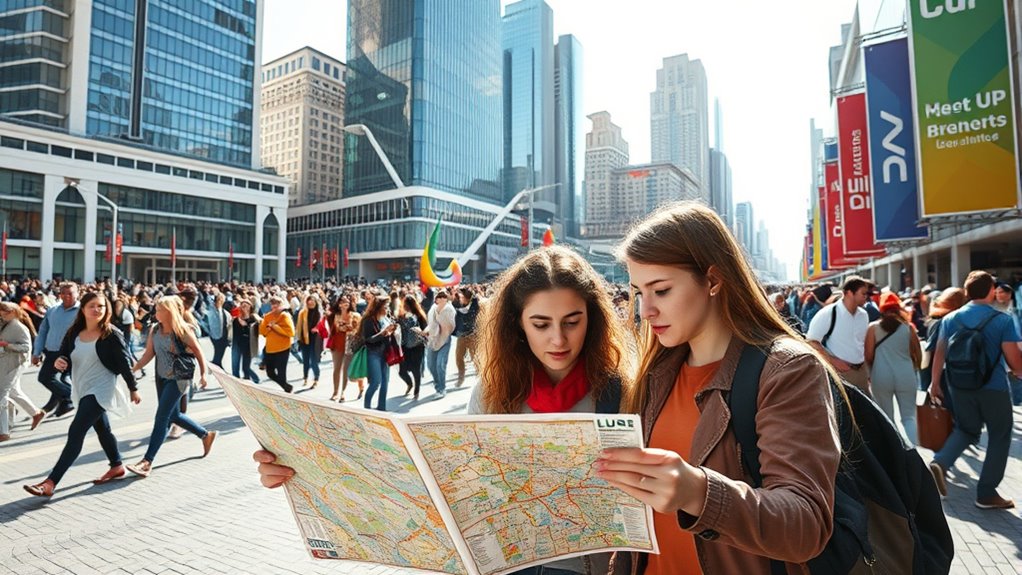To stay found, identify and use landmarks like large rocks, unique trees, or water bodies to navigate and communicate. Agree on a meet-up point before setting out, such as a prominent rock or trail junction, so everyone knows where to regroup. Create visible signals like stacked rocks or signs near landmarks to attract help and mark your location. Staying near familiar landmarks and using signals smartly increase your chances of rescue—if you keep going, you’ll discover even more effective strategies.
Key Takeaways
- Choose distinctive, reliable landmarks like large rocks or unique trees for navigation and rendezvous points.
- Agree on a specific landmark as a meet-up spot before entering wilderness to ensure easy reunion.
- Use photos, maps, or mental notes to remember landmarks’ locations for effective orientation.
- Create visible signals, such as stacking rocks or tying cloth, near landmarks to attract rescuers’ attention.
- Stay near your designated landmark if waiting for help, avoiding wandering to increase rescue chances.

Have you ever wondered what to do if you get lost in the wilderness? It’s a question that might run through your mind when you’re deep in nature, away from familiar landmarks and help. The key to staying found is knowing how to use landmarks and meet-up tactics effectively. First, you need to recognize that landmarks are your best friends. They’re fixed points in the landscape you can use to orient yourself or communicate your location. Trees with unique features, distinctive rock formations, bodies of water, or even man-made structures like towers or buildings can serve as reliable references. When you realize you’re lost, take a moment to identify these landmarks. Use your camera or phone to snap pictures if possible, so you can compare your surroundings later. Marking these points on a map or in your mind will help you understand your position better and plan your next move. Recognizing familiar landmarks can also help you navigate more confidently and reduce confusion in unfamiliar terrain.
Next, establish a meeting point if you’re with others. Before heading into the wilderness, it’s wise to agree on a specific landmark as your rendezvous spot, such as a large rock, a fallen tree, or a trail junction. If you get separated, everyone should head toward that designated point rather than wandering aimlessly. This tactic increases the chances of reuniting quickly and reduces confusion. If you’re alone, it’s still smart to pick a landmark that’s visible from a distance and easy to find again. Use this as your reference point to either stay put or navigate back to safety. When choosing a meeting spot, pick something that’s unlikely to be hidden by foliage or weather, ensuring it remains visible.
In addition to landmarks, use your surroundings to create signals that others can recognize. For example, if you spot a distinctive tree, a large rock, or a unique pattern in the landscape, mark it by stacking rocks or tying a piece of cloth to a branch. These signals serve as visual cues for rescuers or fellow hikers. Remember, staying in one place near your landmark is often safer than wandering further away, especially if you’re uncertain of your direction. If you’re waiting for help, stay visible by creating signals such as a large “HELP” sign with logs or rocks, or by using a whistle to make noise periodically. Combining landmark awareness with clear meet-up tactics greatly improves your chances of being found and returning safely from the wilderness.
Frequently Asked Questions
How Do Different Weather Conditions Affect Landmark Visibility?
Different weather conditions can markedly impact landmark visibility. For instance, fog and heavy rain reduce visibility, making landmarks harder to see and identify. Snow can obscure features or create reflective glare, while bright sunlight can cause glare or shadows that hide details. Windy conditions might move objects or cause debris, further complicating sightlines. To stay found, adapt your navigation by using multiple landmarks and relying on tools like compass and GPS during adverse weather.
What Are the Best Digital Tools for Landmark Navigation?
Think of digital tools as your trusty compass in a dense forest. Apps like Google Maps, Gaia GPS, and Komoot act as your guiding stars, helping you navigate landmarks with ease. You can drop pins, track your path, and even share your location with friends. These tools turn the wilderness into a familiar trail, ensuring you stay found no matter how thick the fog or how dark the night.
How Can I Adapt Meet-Up Plans for Large or Unfamiliar Groups?
You should establish clear, central meeting points that are easy to find and recognizable for large or unfamiliar groups. Use visual cues like signs or balloons, and communicate the plan ahead of time through multiple channels. Assign specific roles or leaders to help guide everyone, and keep the group size manageable to prevent confusion. Regular check-ins and updates make certain everyone stays on track and feels confident in the plan.
What Strategies Work in Areas With Few Recognizable Landmarks?
In areas with few recognizable landmarks, you focus on creating memorable, personalized meeting points. Use color-coded signs, unique clothing, or distinctive objects to stand out. Establish a clear, specific time and location, then confirm details via messages. You could also choose a central, easily remembered spot like a café or park entrance. By making your meet-up simple yet distinctive, you guarantee everyone finds you, even in unfamiliar territory.
How Do Language Barriers Impact Meet-Up Coordination?
Language barriers can make meet-up coordination tricky because you might struggle to communicate locations or instructions clearly. You could miss cues, misunderstand directions, or struggle to confirm details. To overcome this, use simple language, visual aids, or translation apps. Having a designated meeting spot with visual markers or symbols helps, and repeating information guarantees everyone understands. Patience and clear gestures go a long way in bridging communication gaps.
Conclusion
Staying found is all about using landmarks and meet-up tactics to keep yourself safe. Remember, 60% of lost individuals are found within the first 24 hours, emphasizing the importance of quick, strategic actions. By confidently using landmarks and planning meet-up points, you increase your chances of being located fast. So next time you’re exploring, stay aware, stay prepared, and trust your navigation skills—your safety depends on it.










